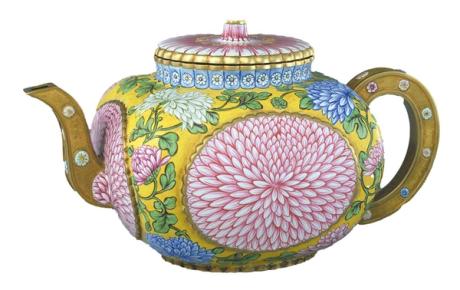[ad_1]

By the late 17th century, Europe had begun to regard China as more than Marco Polo’s land of legends. With an increase in luxury goods—notably porcelain—heading west, and scientific instruments and ideas heading east, the two civilisations grew a bit more familiar, and a bit more envious. This period of what could be called respectful coveting created a golden age of collecting, with the French royal court at Versailles, then Europe’s most splendid, and its Chinese counterpart, the imperial court in Beijing’s Forbidden City, buying, commissioning or just receiving the best of both worlds.Now, the remnants of those two collections are joining together for a display at the Palace Museum in Beijing, revealing a surprising number of crosscurrents and stylistic overlaps—and a unifying love of bling. Roughly covering France’s century leading up to its 1789 revolution, which overlapped with the peak of power of China’s Qing dynasty (1636-1912), The Forbidden City and the Palace of Versailles: Exchanges between China and France in the 17th and 18th Centuries uses around 200 objects and works of art to conjure up the two centres of opulence.The new Chinese exhibition, which will be installed in the Forbidden City’s centuries-old Hall of Literary Brilliance, is a follow up of sorts to the 2014 Versailles show, China at Versailles: Art and Diplomacy in the 18th Century, which only included works from French collections. Originally planned for 2020 and then postponed by the pandemic, the new show takes advantage of the decade-long gap by including more recently acquired French works, such as a porcelain service commissioned for Louis XV but made in China. Bearing the French coat of arms, it dates to around 1730.Portrait of Louis XIV surrounded by attributes of the arts and sciences (around 1672) by J. Garnier © Château de Versailles, Dist. RMN © C. FouinLouis XV’s more illustrious predecessor and great-grandfather, Louis XIV, and the Sun King’s Chinese counterpart, Emperor Kangxi (1654-1722), are the patron saints of this show. It was Louis XIV who inaugurated the Bourbon kings’ connection to China in 1685, when his group of Jesuit-mathematician emissaries managed to win favour with Kangxi. The show pairs Versailles’s Portrait of Louis XIV surrounded by Attributes of the Arts and Sciences (around 1672), by Jean Garnier, with the Palace Museum’s undated Qing-era Portrait of Emperor Kangxi in Court Robes.The French monarchs’ perennial reverence for their Chinese confrères is recalled in a fusion work—Plaque depicting the Emperor of China, in which Charles-Eloi Asselin, a painter at the Sèvres Porcelain Manufactory outside Paris, depicted Kangxi’s successor, Emperor Qianlong, on hard-paste porcelain. Based on a drawing by an Italian Jesuit at the Chinese court, the portrait, from around 1776, is presented in a gilded-wood frame decorated with Chinese motifs. It had such a high standing at the court of Louis XVI that it was included in the king’s private Versailles apartments.This skilful combining of East and West can be seen in several objects. A 17th-century black-lacquer clock, inlaid with copper plaques, was made in France during the reign of Louis XIV. Then it made its way to China, where 19th-century restorers replaced the work’s original tortoise-shell marquetry with Chinese-style lacquer work. Versailles’s Marie-Laure de Rochebrune—who is curating the show together with the Palace Museum’s Guo Fuxiang—describes this conflation as “very interesting and very funny”.De Rochebrune, who is a porcelain specialist, was herself fooled by another fusion work—a 1780s teapot made in France for Emperor Qianlong by Joseph Coteau, the celebrated French enameller, and now in the Palace Museum collection. Decorated with Chinese-style chrysanthemums, the object was made using a translucent enamel-glaze technique pioneered in France but later imitated in China. “When I first saw it,” says de Rochebrune, who has made trips to Beijing in preparation for the show, “I thought it was a Chinese object.”A 17th-century French pocket watch with a gold-plated dragon Palace MuseumFrench and Chinese craftsmanship also combine in a Palace Museum pocket watch. The 17th-century piece, made in Paris’s Thuret workshop, was most likely a gift to Emperor Kangxi from Louis XIV, whose portrait is featured on the back of the gold-plated copper case. Though French on the outside, on the inside an elaborate gold-plated dragon was inserted in China to protect the watch spring.These days, France and China are still engaging in a version of diplomacy related to the finer things. The show was formally reconfirmed in spring 2023, during the French president Emmanuel Macron’s state visit to China—a red-carpet affair that was “little short of a love fest”, according to The New York Times. The visit’s fusion of the political and cultural may have had additional implications, says J.P. Singh, a professor of political economy at Virginia’s George Mason University and an editor at the journal Global Perspectives. The show’s invocation of a shared tradition in luxury, Singh says, not only dramatises the two countries’ cultural history but reminds China of France’s current status as a leading exporter of everything from expensive clothes to perfume. “Luxury goods are also a kind of cultural product,” he adds.• The Forbidden City and the Palace of Versailles: Exchanges between China and France in the 17th and 18th Centuries, Palace Museum, Beijing, 1 April-30 June
[ad_2]


























